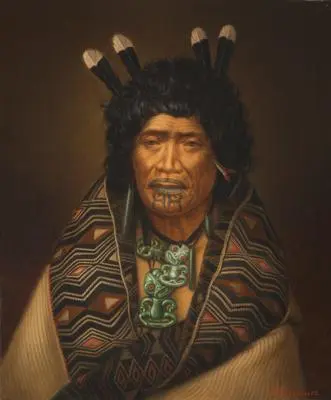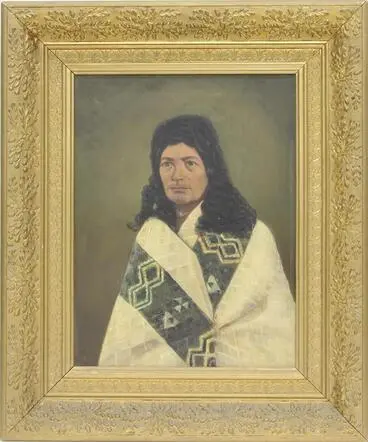Te Rangitopeora
A DigitalNZ Story by National Library Services to Schools
Te Rangitopeora (also known as Rangi Topeora) was a niece of Te Rauparaha and sister of Te Rangihaeata. She was one of very few women to sign the Treaty of Waitangi.
These resources and text relate to Te Rangitopeora (Ngāti Toarangatira and Ngāti Raukawa). They have been sourced and collated from DigitalNZ and other websites.
Rangi Topeora
Auckland Art Gallery Toi o Tāmaki
Background
Te Rangitopeora
Te Rangitopeora was a renowned woman of rank of Ngāti Toarangatira and Ngāti Raukawa. She was a niece of Te Rauparaha and sister of Te Rangihaeata. She was one of the very few women to sign the Treaty of Waitangi in 1840.
Te Rangitopeora (also known as Rangi Topeora), of Ngāti Toa and Ngāti Raukawa, was born at Kawhia early in the nineteenth century. Her hapū (sub-tribe) were Ngāti Kimihia and Ngāti Te Maunu. She was a niece of the great Ngāti Toa leader Te Rauparaha, and a sister of the formidable warrior Te Rangihaeata.
As a young woman, she was a famous composer of waiata, and many of her songs are still sung today. In the early 1820s, she migrated south to Kapiti Island and adjacent mainland districts with her people, to escape the growing conflict with other Waikato tribes. Her actions during this turbulent migration, and once her people arrived in the south, marked her as a leader and a woman of great strength.
In May 1840 the missionary Henry Williams brought the Treaty of Waitangi to Kapiti Island. Te Rangitopeora was one of an estimated five to thirteen women to sign the Treaty.
When her brother Te Rangihaeata became involved in armed conflict with British troops and settlers in 1846 she became an opponent of the government. She remained an important figure among her people and a notable orator. Later she was reconciled to European settlement.
When Bishop Selwyn baptised her at Ōtaki she insisted on taking the name Kuini (after Queen Victoria), and her husband was named Albert, after Prince Albert, the Queen's husband. She was later commonly known as the "Queen of the South".
Te Rangitopeora died sometime between 1865 and 1873 at Otaki. Her son, Mātene Te Whiwhi, took a leading role in the establishment of the King Movement during the 1850s.
'Te Rangitopeora', URL: https://nzhistory.govt.nz/people/te-rangitopeora, (Ministry for Culture and Heritage), updated 22-May-2018Adapted from the DNZB biography by Teremoana Sparks and W. H. Oliver
Lindauer's painting of Te Rangitopeora
In Lindauer's painting above, Te Rangitopeora is wearing three pounamu hei tiki, three pounamu drop pendants, a shark tooth and red seal wax earring, four huia feathers in her hair and a kaitaka korowai (cloak with double tāniko borders). She also has a moko kauae. Each of these taonga reveals how much mana she had in her community and beyond.
Fertile questions
- Why was it that some Māori women signed Te Tiriti o Waitangi in 1840 but could not vote until 1893?
- Who gets their portrait painted?
- What does this portrait say about Te Rangitopeora?
- He aha ngā tikanga i ngā wā o mua kia mau moko kauae koe? Kei te mana tonu ērā tikanga i ēnei rā?
- What questions do you have?
Rangi Topeora
Auckland Art Gallery Toi o Tāmaki
Topeora - (Te Ao Hou - No. 52 September 1965)
Alexander Turnbull Library
Quick facts
- Te Rangitopeora was a noted composer and mediator. She rejected European clothing throughout her life.
- When Bishop Selwyn baptised Te Rangitopeora at Ōtaki she took the name Kuini Wikitoria (Queen Victoria).
- Like the other women that signed the Treaty of Waitangi, Te Rangitoperoa was not yet literate, so she signed by drawing a version of their moko, or facial tattoo.
- Born at Kāwhia early in the 1800s, Te Rangitopeora was also part of Te Rauparaha’s heke of Ngāti Toa and other iwi that travelled from Kāwhia to Kapiti Island.
- Te Rangitopeora was one of between five to thirteen women to sign the Treaty of Waitangi.
- Such was her mana Te Rangitopeora was sometimes referred to as the Queen of the South.
- Mātene Te Whiwhi, Te Rangitopeora’s son, took a leading role in the establishment of the King Movement during the 1850s.
- Te Rangitopeora allowed whalers to use Kapiti Island as a base. This arrangement became a financial asset for Ngati Toa.
Other resources
Artefact, Episode 6 — Huia bird feathers are an artefact and a relic of a prized and now extinct bird.
Rangi Topeora— Gottfried Lindauer painting.
Rangi Topeora— Rangi Toperoa, was of Ngāti Toa and Ngāti Raukawa descent.
She signed— Te Rangitopeora signed the Treaty of Waitangi.
Te mana o te wāhine– historic Māori women of rank.
Te Rangitopeora— a biography.
Te Rangitopeora — a short biography.
Te Rangi Topeora — the Queen of the South.
The Queen of the South — Te Rangitopeora was born at Kawhia in the Waikato.
Women signatories to the Treaty of Waitangi— the Treaty of Waitangi was signed by women of mana as well as male chiefs.
Hei tiki
Manatū Taonga, the Ministry for Culture and Heritage
Kaitaka huaki (cloak with double tāniko borders)
Museum of New Zealand Te Papa Tongarewa
Kaitaka cloaks with tāniko borders
Manatū Taonga, the Ministry for Culture and Heritage
This story was compiled and curated by Te Puna Mātauranga o Aotearoa | National Library of New Zealand, Services to Schools staff, in 2019.





